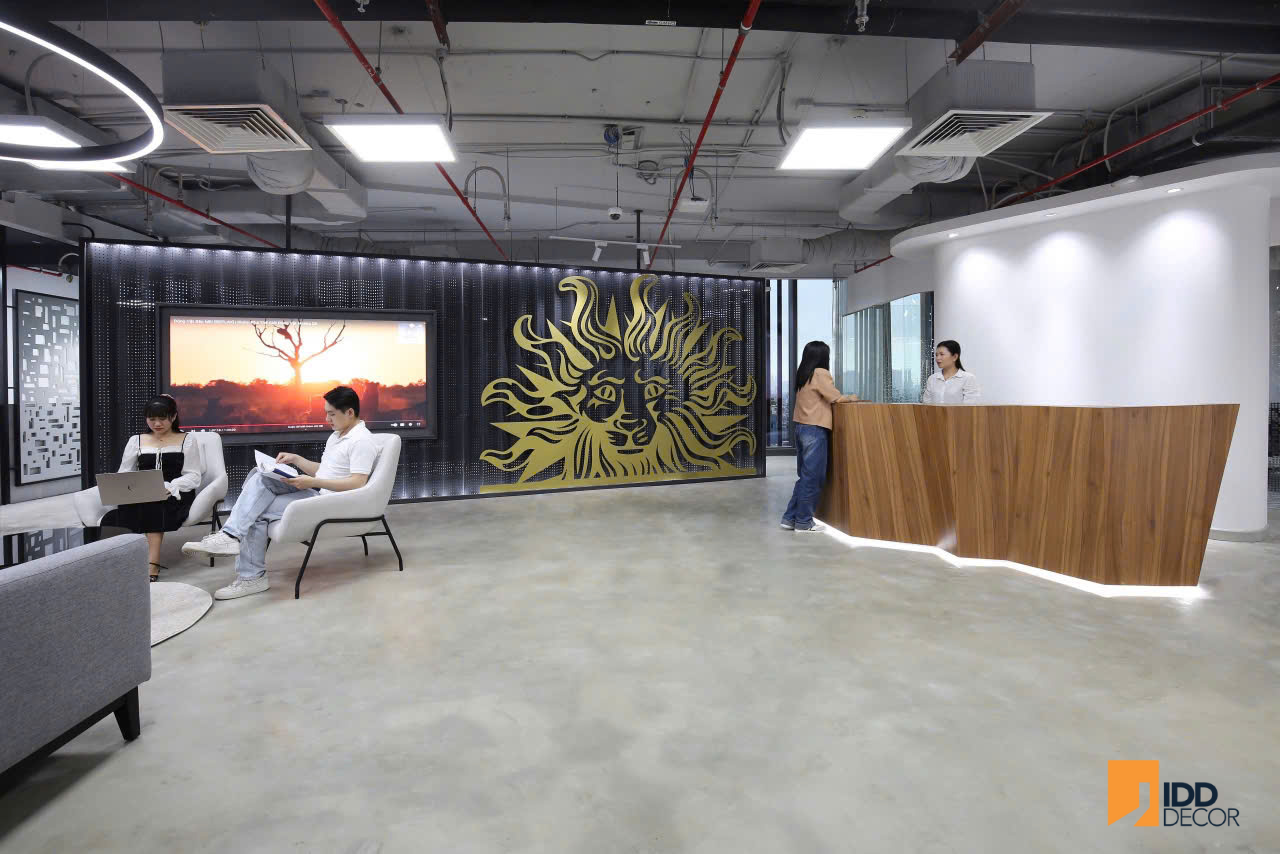
In office interior design and construction, the reception area serves as the “face of the brand” — where first impressions are made for clients, partners, and employees alike. The materials chosen for the reception counter are not merely decorative; they represent a strategic expression of emotion and brand identity.
A reception desk designed with a thoughtful material strategy not only reflects brand culture but also creates a distinct and memorable welcoming experience.
Research in interior design shows that materials can directly influence how people perceive a space. For example:
Natural stone conveys luxury and stability.
Natural wood or veneer creates warmth and familiarity.
Glass and metal evoke modernity and professionalism.
When a visitor enters the office, encountering a reception desk with the right material instantly triggers a positive emotional response, enhancing their overall impression.
Beyond emotional impact, materials serve as a visual language of brand personality.
A technology company might favor glass, steel, and reflective finishes to emphasize innovation.
A financial corporation often prefers granite or high-end wood to express solidity and trust.
Every organization has its own set of core values, and material choices should align with that identity. For example:
Sustainability-driven companies prioritize recycled wood, eco-materials, or low-VOC coatings.
Creative firms opt for vibrant, unconventional materials — mixing wood, felt, and textured paint to express originality.
A successful reception design achieves a refined balance between different materials:
Stone + Wood: a contrast between strength and warmth.
Glass + Metal: modernity and sophistication.
Fabric + Wood: softness and approachability.
The modern trend is to prioritize eco-friendly materials — FSC-certified wood, low-VOC paints, and recycled composite stone. This not only reduces the carbon footprint but also enhances a company’s image in the eyes of global partners.
In office interior design, natural and engineered stone are leading choices for reception desks thanks to their luxurious appearance and durability. Granite and marble bring a sense of authority and prestige, often chosen by financial institutions, real estate developers, and large corporations.
Meanwhile, engineered stone offers a more versatile, cost-effective alternative — available in a wide range of colors and shapes, ideal for modern offices seeking elegance with efficiency.
Wood and wood-like materials bring a contrasting atmosphere — warm, welcoming, and human-centric.
Natural wood is ideal for premium, high-end receptions.
Engineered or faux wood suits young, dynamic companies aiming for a friendly yet professional image.
For companies seeking minimalism and innovation, glass and metal are ideal. Transparent glass combined with polished metal expands visual space while symbolizing transparency, agility, and creativity — reasons why many tech startups and media firms prefer these materials.
In recent years, green materials have become a global standard. Recycled wood, bamboo, rattan, and repurposed composite stones reduce environmental impact while demonstrating corporate commitment to sustainable development.
Additionally, low-VOC paints and eco-friendly coatings are increasingly favored by international companies focused on ESG (Environmental – Social – Governance) compliance.
Each material not only contributes to aesthetics but also reflects a company’s strategic branding approach.
Example: CEVA Logistics Headquarters
The reception counter at CEVA Logistics uses light-toned stone surfaces with accent lighting, creating a professional image that mirrors the stature of a global logistics enterprise.
Advantages: luxury, strength, and timeless appeal.
Disadvantages: natural stone is heavy, costly, and difficult to install; engineered stone is lighter and more affordable but less durable.
Example: Publicis Group Vietnam
Publicis’ reception area combines wood finishes with a modern design, producing an atmosphere that is both elegant and human-centered.
Advantages: warmth, friendliness, and comfort.
Disadvantages: natural wood requires maintenance against moisture and warping; engineered wood is less durable but cost-effective.
Example: VPIC Headquarters
At VPIC, the reception area uses silver-toned metal and large glass panels, creating a spacious and transparent impression that reflects the company’s industrial precision.
Advantages: modernity, minimalism, and openness.
Disadvantages: easily shows smudges and can feel cold without warm lighting or textures to balance.
Eco-friendly materials are increasingly preferred, especially by companies integrating ESG principles. Bamboo, recycled timber, and low-VOC paints minimize environmental impact while reinforcing a company’s social responsibility.
Challenges: higher costs and occasional supply limitations.
In office interior design and construction, the reception area is a strategic space that shapes brand perception.
Materials are more than aesthetic choices — they are the language of emotion and identity.
A well-considered material strategy can elevate corporate image and deliver a positive, lasting impression from the very first encounter with clients and partners.
IDD Decor – Office Interior Design – Behind the Door Awaits the Journey to Success
📍 Address: Doxaco Building, 307B Nguyen Van Troi Street, Tan Son Hoa Ward (formerly Ward 1, Tan Binh District), Ho Chi Minh City
📞 Hotline: 0896 640 986
🌐 Website: idddecor.com
🔗 LinkedIn: linkedin.com/company/idddecorvn